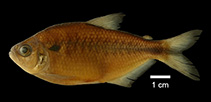Astyanax boliviensis Ruiz-C., Román-Valencia, Taphorn, Buckup & Ortega, 2018
Hochladen Photos und videos
Pictures | Google BildAstyanax boliviensis
Picture by Ruiz-C., R.I. et al., 2018
Pictures | Google BildAstyanax boliviensis
Picture by Ruiz-C., R.I. et al., 2018
Common names from other countries
Klassifizierung / Names Namen | Synonyme | Catalog of Fishes(Gattung, Arten) | ITIS | CoL | WoRMS | Cloffa
> Characiformes (Characins) > Characidae (Characins; tetras) > Stethaprioninae
Etymology: Astyanax: The name of Astyanax, Hector´s son in the Greek mythology (Ref. 45335); boliviensis: Named for the country where the type series was collected, Bolivia.
Eponymy: Astyanax was the son of Hector in Greek mythology. See Homer’s Iliad for details. The reasoning for its use for a genus of characins is not explained. (Ref. 128868), visit book page.
Etymology: Astyanax: The name of Astyanax, Hector´s son in the Greek mythology (Ref. 45335); boliviensis: Named for the country where the type series was collected, Bolivia.
Eponymy: Astyanax was the son of Hector in Greek mythology. See Homer’s Iliad for details. The reasoning for its use for a genus of characins is not explained. (Ref. 128868), visit book page.
Environment: milieu / climate zone / depth range / distribution range Ökologie
; süßwasser benthopelagisch. Tropical
Verbreitung Länder | FAO Gebiete | Ecosystems | Vorkommen | Point map | Einführungen | Faunafri
South America: Upper Amazon River Basin of Bolivia and Peru.
Size / Gewicht / Alter
Kurzbeschreibung Bestimmungsschlüssel | Morphologie | Morphometrie
Rückenflossenweichstrahlen (insgesamt) : 9. This species which is a member of the orthodus species-group of Astyanax differs from other species of the group in having lines extending from the tips of the chevrons on both the anterior and posterior extremes (proximal and distal sections of chevron extensions), forming etensions between the chevrons (vs. chevrons without lines extending from their tips), except A. moorii which is distinguished by the number of lateral-line scales 39-42 (vs. 44–50); also differs from A. moorii in the upper jaw length > 34% HL (vs. < 47% HL); further differs from A. villwocki by the absence of a dark stripe on the sides of the body (vs. with dark lateral stripe or anterior prolongation of the caudal peduncle spot extending over the silvery lateral stripe); differs from orthodus, embera, yariguies in having a distinct rhomboidal caudal-peduncle spot with a short, anterior, prolongation that does not surpass a vertical through the anal-fin origin (vs. spot on caudal peduncle a short polygon shape not surpassing the posterior tip of the anal fin in orthodus, embera and spot on caudal peduncle elongated as a stripe, continuing anteriorly to humeral region in A. villwocki; differs from A. bopiensis in having , 4 teeth extending over less than one third of the maxillary (vs. > 5 teeth extending over more than two thirds of the maxillary) (Ref. 119406).
Life cycle and mating behavior Geschlechtsreife | Fortpflanzung | Ablaichen | Eier | Fecundity | Larven
Hauptreferenz
Upload your references | Referenzen | Koordinator | Partner
Ruiz-C., R.I., C. Román-Valencia, D.C. Taphorn, P.A. Buckup and H. Ortega, 2018. Revision of the Astyanax orthodus species-group (Teleostei: Characidae) with descriptions of three new species. European Journal of Taxonomy 402:1-45. (Ref. 119406)
Bedrohung für Menschen
Harmless
Nutzung durch Menschen
FAO(Publication : search) | FishSource |
Mehr Information
Trophic ecology
Nahrungsorganismen
Nahrungszusammensetzung
Nahrungsaufnahme
Food rations
Räuber
Nahrungsorganismen
Nahrungszusammensetzung
Nahrungsaufnahme
Food rations
Räuber
Ecology
Ökologie
Home ranges
Ökologie
Home ranges
Population dynamics
Growth parameters
Max. ages / sizes
Length-weight rel.
Length-length rel.
Längenhäufigkeiten
Mass conversion
Rekrutierung
Dichte
Growth parameters
Max. ages / sizes
Length-weight rel.
Length-length rel.
Längenhäufigkeiten
Mass conversion
Rekrutierung
Dichte
Life cycle
Fortpflanzung
Geschlechtsreife
Fecundity
Ablaichen
Spawning aggregations
Eier
Eientwicklung
Larven
Larven Pop.Dyn.
Fortpflanzung
Geschlechtsreife
Fecundity
Ablaichen
Spawning aggregations
Eier
Eientwicklung
Larven
Larven Pop.Dyn.
Anatomy
Kiemenoberfläche
Brain
Otolith
Kiemenoberfläche
Brain
Otolith
Physiology
Body composition
Nutrients
Oxygen consumption
Swimming type
Swimming speed
Visual pigments
Fish sound
Diseases & Parasites
Toxicity (LC50s)
Body composition
Nutrients
Oxygen consumption
Swimming type
Swimming speed
Visual pigments
Fish sound
Diseases & Parasites
Toxicity (LC50s)
Genetics
Genetik
Heterozygosity
Vererbbarkeit
Genetik
Heterozygosity
Vererbbarkeit
Human related
Aquaculture systems
Aquakultur Profile
Zuchtlinien
Ciguatera cases
Stamps, coins, misc.
Aquaculture systems
Aquakultur Profile
Zuchtlinien
Ciguatera cases
Stamps, coins, misc.
Tools
E-book | Feldführer | Längenhäufigkeits Tool | Lebensdaten Tool | Punkt Karte | Classification Tree
| Catch-MSY |
Zusatzinformationen
Download XML
Zusammenfassung | Point data | Namen | Photos
Internet Quellen
Aquatic Commons | BHL | Cloffa | Websites from users | FishWatcher Einträge suchen | CISTI | Catalog of Fishes(Gattung, Arten) | DiscoverLife | ECOTOX | Faunafri | Fishtrace | GenBank(Genom, nucleotide) | GloBI | GOBASE | | Google Books | Google Scholar | Google | IGFA World Record | MitoFish | Otolith Atlas of Taiwan Fishes | PubMed | Reef Life Survey | Scirus | SeaLifeBase | Tree of Life | Wikipedia(Gehe zu, Suchen) | World Records Freshwater Fishing | Zoobank | Zoological Record
Estimates based on models
Phylogenetic diversity index (Ref. 82804): PD50 = No PD50 data [Uniqueness, from 0.5 = low to 2.0 = high].
Bayesian length-weight: a=0.01738 (0.00782 - 0.03863), b=3.06 (2.89 - 3.23), in cm Total Length, based on LWR estimates for this Genus-body shape (Ref. 93245).
Trophic level (Ref. 69278): 2.9 ±0.4 se; based on size and trophs of closest relatives
Widerstandsfähigkeit (Ref. 120179): hoch, Verdopplung der Population dauert weniger als 15 Monate. (Preliminary K or Fecundity.).
Fishing Vulnerability (Ref. 59153): Low vulnerability (10 of 100).




